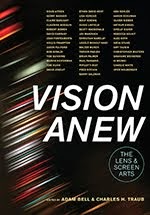
My review of Andrey Tarkovsky's: Films, Stills, Polaroids, and Writings (Schirmer/Mosel, 2013) is now available on photo-eye. You can get the book here.
________________________________________
How does one contain a film within a book? Distill the 24 frames per second into the pages of a book? In many respects, any such attempt is half-hearted and can only point and freeze moments from something fluid. Andrey Tarkovsky is a towering figure in film history influencing such contemporary directors as Béla Tar, Hou Hsaio-Hsien and Theo Angelopoulos, as well as countless others. Although the Russian filmmaker only made a handful of films in his lifetime (five in his native Russia and two in exile in Italy), his cerebral, purposefully enigmatic and arrestingly beautiful films continue to captivate audiences. Perhaps best know in the United States for the films Stalker and Solaris, Tarkovsky also wrote extensively about cinema and enjoyed taking pastoral and meditative Polaroid pictures of his life in Russia and later in Italy. Edited and compiled by Tarkovsky's son, Andrey Tarkovsky Jr. and Hans-Joachim Schlegel, this new retrospective monograph offers a survey of his films, writings and photographs.

As a fan of Tarkovsky's work, I'm sad to say I'm a bit disappointed by the book. In its overly reverential approach, the book feels like a missed opportunity to reassess Tarkovsky's work and his continued relevance. Understandably, Tarkovsky's son is seeking to secure his father's place in cinematic history and provide a lasting record of his films. The problem is such a record already exists – in the films themselves.
The bulk of the large book is devoted to Tarkovsky's seven films. Each is given its own section with roughly twenty-five stills per movie and a short intro that includes production notes and a brief description of the plot. Tarkovsky's films' are notoriously slow and evocative. Unfortunately, the plot summaries read like stilted bullet-points and the skeletal descriptions suck the life from the subtle nuances and often moving narratives of the films. The stills for many of the early films also look like screen-grabs from the digital transfer and contain ugly digital pixilation. Pulling a still from an existing print is a costly effort, and was perhaps prohibitive for this book, but the poor quality detracts from an otherwise beautiful shot. There is also little behind-the-scenes imagery, which would have provided further context to the film and its production. It is possible that there was no still photographer or that any production photographs were simply left out to focus on the films; the most likely answer is they've vanished into a bureaucratic hole in the former Soviet Union when Tarkovsky became a persona non grata and went into exile. For a scholar of Tarkovsky, the over 200 pages of movie stills might prove useful, but any fan will return to the films.


The book also contains a wide-range of writings about and by Tarkovsky. Opening with a nice retrospective essay by Hans-Joachim Schlegel, the book also features historical reviews and writings by Sartre, Ingmar Bergman, excerpts from Tarkovsky's book Sculpting in Time: Reflections on the Cinema and several brief autobiographical pieces. The essays and historical writings give a sense not only of Tarkovsky's influential role during his life, but also his continued importance. Concluding the book are two sections: a modest photo album of Tarkovsky's family, and a selection of personal Polaroids from the early 80s shot in Russia, and later in Italy, while Tarkovsky was in exile.


It seems unfair to be negative about an artist I admire, but Tarkovsky deserves more. In the end, the numerous stills 'doth protest too much,' feeling more like a monument than an energized or fresh look at Tarkovsky's work. However, now that such a reverential book exists, perhaps it leaves room for a more inventive and engaging approach that can bring Tarkovsky alive for a new generation. For now, rent Stalker or Ivan's Childhood, read Geoff Dyer's Zona, and if you're hooked, delve more deeply into the few films he left us to ponder.
Please note: This review originally appeared on photo-eye magazine on Friday, June 14th, 2013. You can get the book here.





